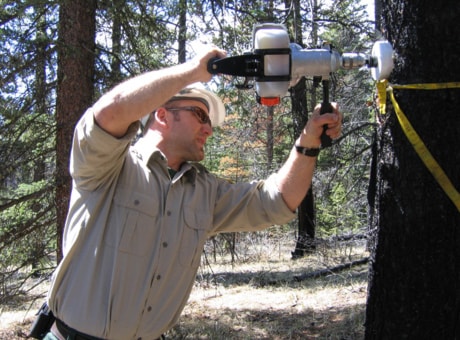In a stand of lodgepole pine and spruce trees, on the eastern slopes, west of Sundre, lies the answer to how large a challenge the mountain pine beetle will be this year.
The insect — the size of a fat black grain of rice — was first found in large numbers in the woods, close to the Ya Ha Tinda Ranch, in 2007.
That year, 50 trees had some evidence of the tiny pests. Last fall, around 30 new trees were found. All but four of the trees were destroyed last fall.
Now it’s up to Alberta Sustainable Resource Development staff to explore what has happened to the four remaining trees, marked with yellow ribbons, and left over the winter.
Kristofer Heemeryck, forest health officer for the Clearwater Forest area, and a handful of others trek into the woods, seeking out the trees in order to do R-value surveys. The surveys are done throughout the province in May and June to give the government an idea where the worst outbreaks of the mountain pine beetle are in Alberta. The government will use the information gained to decide how to fight the pest.
Heemeryck says they have seen an increase in the number of beetles in their bait trees in the area over the last two years.
Last year, there were eighty pitch tubes — holes where the beetle has dug into the tree — in their baited trees. This year, there were around 250 pitch tubes in their baited trees. The trees are baited with a pheromone — a hormone that attracts the opposite sex to the tree.
So far, the only trees that have been affected in the area have either been the baited trees or pine trees that were scorched and stressed, as a result of a prescribed burn in the area in 2007. When trees are stressed they aren’t as able to produce a resin that could push the beetles out.
The pitch tubes, where the beetles have entered are visible from the outside of the lodgepole pines that have been left for the survey. The pitch tubes are little round holes, around a centimetre in diameter, with amber-coloured resin oozing out and down the side of the tree bark.
Heemeryck revs up his gas-powered drill to cut out four samples of the tree’s bark and sap wood. The samples are flat discs around the diameter of a large orange. They are taken at shoulder height from the north and south sides of the tree.
As the blade cuts into the bark the crew watches to see what will be revealed underneath. If a tree is infested with mountain pine beetle it could easily be crawling with wriggling larvae, similar looking to maggots squirming in a garbage heap.
The whine of the drill cuts through the bark of the tree, making clean circles. Heemeryck takes out a chisel and hammer to pluck the pieces of wood free.
Although there are little black adult carcasses in the tree that are lying dead or dormant, there are no wriggling larvae.
Not seeing any larvae in the tree is a relief to the Sustainable Resource Development staff. It means the beetles in those trees haven’t reproduced.
The actual findings from the surveys won`t be available until the samples can be examined back at the lab and the survey results from around the province are released in June, but it’s looking good so far. After the surveys the remaining trees are cut down and peeled to kill off the mountain pine beetle.
The forests, west of Sundre, haven’t seen the same onslaught of beetles as B.C. or the north or south of Alberta.
Heemeryck says they aren’t sure why, but the icefields close by could be stopping their movement from B.C. into that part of Alberta. “We`re still a head of it here and we want it to stay that way.”
He explains the trees are crucial in the area because healthy forests are key to a healthy ecosystem.
“It’s OK to kill some (trees), burn some or log some, but when we get these massive waves it starts to impact our water and our wildlife habitat,” Heemeryck says. Trees help to filter water, stabilize slopes and hold snow pack, which helps with late summer water supplies, he says.
“It’s a natural pest. We’re not going to eradicate it forever in here, but we’ll try to do what we can.”
sobrien@www.reddeeradvocate.com
